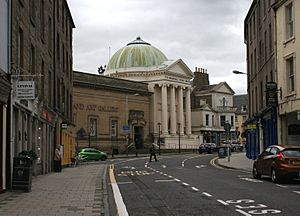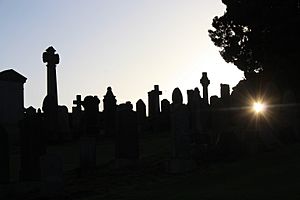Magnus Jackson facts for kids
Quick facts for kids
Magnus Jackson
|
|
|---|---|
| Born | 25 September 1831 |
| Died | 27 April 1891 (aged 59) |
| Resting place | Wellshill Cemetery, Perth, Scotland |
| Nationality | British |
| Known for | Photography |
Magnus Jackson (born September 25, 1831 – died April 27, 1891) was a Scottish landscape photographer. He was famous for his pictures of nature and places. Magnus Jackson lived in Perth, Scotland.
He used an old photography method called the collodion process. This was a special way to develop photographic film in his time. He left behind about 2,500 glass negatives. These are like old-fashioned photo films. They show Perth and the areas around it from the late 1850s to 1890. You can see them today at the Perth Museum and Art Gallery.
In 2017, the Perth Museum and Art Gallery had a special show of Jackson's work. It lasted for four months. The exhibit even had a projected silhouette of Jackson. It showed him talking about how hard it was to use his wet-plate collodion photography method.
Contents
Early Life and Photography Beginnings
Magnus Jackson was born on September 25, 1831. His parents were Thomas Jackson and Helen Miller. He was one of their six children. His father made picture frames and fixed old oil paintings. He also sold prints. Their family business was at 70 George Street. Their home was just behind it on Bridge Lane.
Magnus later took over the family business. He continued to run it while also working as a photographer. In the early 1850s, Jackson went to London. He took lessons there to learn about wet-plate collodion photography. This was a new and exciting way to take pictures back then.
After three years, he came back to Perth. He started his own photography business. His first studio was a wooden building in Marshall Place. It was on the land where St Leonard's-in-the-Fields Church is today. From there, he could see the city's South Inch park.
Photography Career and Achievements
By 1884, Magnus Jackson was very successful. He earned enough money to build a new studio. This new place was at 62 Princes Street. It was right next to Greyfriars Burial Ground. In the same year, he won an award. He got a medal at the International Forestry Exhibition in Edinburgh.
In 1886, he won another award. He received a bronze medal and a special diploma. This was at the International Exhibition of Industry, Science and Art in Edinburgh. He won for his beautiful photographs of ferns and foxgloves.
As Magnus Jackson's health got worse in the late 1880s, his sons took over. His sons, Thomas and Magnus Jr., ran the business. They used the name T. & M. Jackson starting in 1891. Later, the business closed down. Another photography company, Burrows Brothers, took over the studio.
Personal Life and Community Roles
Magnus Jackson married Jessie Christie in December 1859. They first lived in Bridge Lane. As they earned more money, they moved to bigger homes. First, they moved to 30 James Street in 1870. Then, they moved to 59 Scott Street.
Magnus and Jessie had three children. Their sons were Thomas (born 1861) and Magnus (born 1865). Their daughter, Catherine Stewart, was born in 1863. All of their children learned photography from their father. In 1897, Thomas moved to South Africa. He continued to work as a photographer there.
In 1877, Jackson became a member of the Perthshire Society of Natural Science (PSNS). This group studied nature. The next year, he was elected to Perth's town council. This meant he helped make decisions for the town.
In 1879, he helped build the Perthshire Society of Natural Science Museum. It is now at 62–72 Tay Street. He was elected to the PSNS council the next year. He became a vice-president from 1882 to 1884. During this time, he showed his work called A piece of larch from a tree which had been struck by lightning.
In 1885, he became a Police Commissioner for Perth. This job meant he helped manage the police, street lights, and fire services. In his later years, Jackson was also on the council of the Society of Antiquaries of Scotland. This group studied old things and history.
He supported the Literary and Antiquarian Society of Perth. He gave them a brass candlestick. It was said to have been given to one of his ancestors by William Wallace. This candlestick is now at the Perth Museum and Art Gallery.
In 1887, he was part of a group that helped people with cholera. They found a safe place on the River Tay for a boat carrying sick people. This helped them get treatment and stay separate from others.
Two years before he died, in May 1889, he officially opened Perth's public swimming baths. These were on Dunkeld Road. His wife, Jessie, passed away two months later, in July.
Death and Legacy
Magnus Jackson died on April 27, 1891. He was 59 years old. He had been sick for several years. His newspaper obituary said he was "known across Scotland as a first-rate landscape photographer."
Magnus Jackson and his wife are buried together in Perth's Wellshill Cemetery.
Publications
- Photography Outside the Studio (1881) – This was published in two parts. It appeared in both The Photographic News and the British Journal of Photography.




